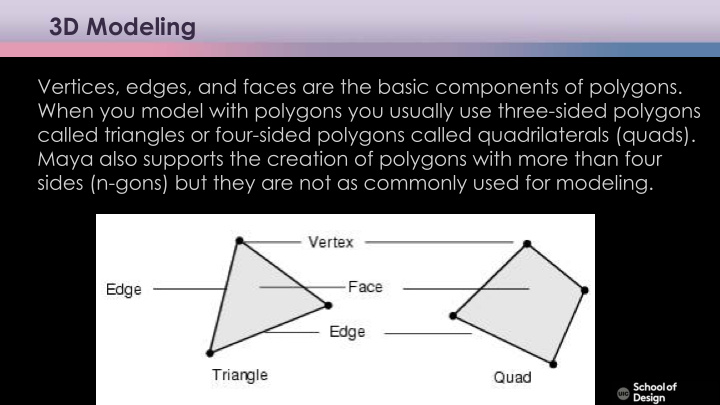



3D Modeling Vertices, edges, and faces are the basic components of polygons. When you model with polygons you usually use three-sided polygons called triangles or four-sided polygons called quadrilaterals (quads). Maya also supports the creation of polygons with more than four sides (n-gons) but they are not as commonly used for modeling. Computer Science
3D Modeling edges Computer Science
Normals Normals are imaginary lines perpendicular to each point on a curve or surface (NURBs), or to the surface of a polygon (Polygon) In Maya, normals are used to determine the orientation of a polygon face (face normals), or how the edges of faces will visually appear in relation to each other when shaded (vertex normals). Face normal Computer Science
Normals Vertex normals You can modify the shading of individual polygons by manually editing the vertex normals associated with the polygon mesh. Since they are always perpendicular to the curve or surface, the way normal lines point toward or away from each other can reveal subtle curvature. Computer Science
Creating polygons Using primitives (Create / Polygon Primitives) • Creating Polygon from scratch (Mesh Tools / Create Polygon Tool) • Computer Science
Primitives Computer Science
Creating polygons Smoothing polygons smoothing polygons Computer Science
Creating polygons Editing in component mode Transform vertices, edges, and faces • Extrude faces or edges (Edit Mesh / Extrude) • Split faces using snap (Mesh Tools / Multi-Cut) • Combine or separate meshes • Merge vertices, edges, and faces • Delete vertices, edges, and faces • Append the deleted faces (Mesh Tools / Append to Polygon) • Computer Science
3D modeling Real-time vs recorded Real-time: rendering for interactive media, such as games and simulations, is calculated and displayed immediately. It uses the viewer's PC processor and graphics card to produce individual frames of animation as they are displayed. Non real-time (offline rendering): animations for non-interactive media, such as feature films and video, are rendered much more slowly and presented as video files. Non-real time rendering enables the leveraging of limited processing power in order to obtain higher image quality. Computer Science
3D modeling A screenshot image of Minecraft scene: Stonehenge in Wiltshire, recreated in Minecraft blocks by Ordnance Survey Innovation Lab. Computer Science
3D modeling 3D coordinate system The 3D world in computer graphics applications is visualized using a Cartesian coordinate system. Computer Science
3D modeling Navigating display windows View panel change (Space Bar or check the left area layout) : Single View vs. Four View Perspective View + Orthographic View Tumble, Track, Dolly Tool (Alt (option) + Mouse Button (left, middle, right button)) Computer Science
Hierarchy View panel Check out objects in the scene. Each modeling object is consisted with transform and shape nodes. You can control their hierarchical relations in these windows: Outliner window Hypergraph window Computer Science
Hierarchy Group vs. parent Toggle on [Outliner/Display/Shapes] to show shape node along with transform node. It is important to understand the relations between a transform node and its manipulator's position as a pivot point, when you move, rotate, and scale an object. Computer Science
Hierarchy Move the pivot point Changing the pivot , which is a center of manipulator insert key, or fn + left arrow key, or d key Computer Science
3D modeling examples 3D printing of a generative design lamp Image courtesy of Nervous System. Computer Science
3D modeling examples 3D printing of a generative design lamp Image courtesy of Nervous System. Computer Science
3D modeling examples Timothy J. Reynolds, Low poly art, AWWWARDS Paper City Vimeo Kenneth A. Huff Meats Meier Game of Thrones intro Official Show Open Art of VFX What software was used to create the intro for Game of Thrones (TV series)? Pixar Animation- Luxo Jr. Timothy j. Reynolds Computer Science
Computer Science
Computer Science
A high-resolution interactive 3D visualization developed in 3D modeling software displayed in real-time global-scale data visualization renderer Computer Science
DataVis Workshop EVL Daria Tsoupikova Associate Professor School of Design Electronic Visualization Lab (EVL) Computer Science
Recommend
More recommend